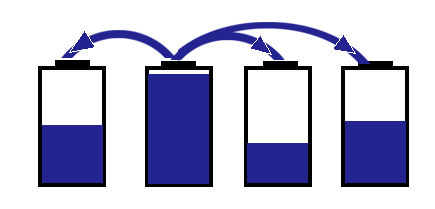battery balancing
In multi-cell batteries with battery cells connected in series, the weakest battery cell determines the battery capacity of multi-cell batteries. Therefore, taking into account the aging process, all battery cells should have the identical battery capacity. Battery balancing is an intelligent solution for this.
In lithium-ion batteries and lithium-polymer batteries, the battery capacities of the individual battery cells change during charging and discharging due to chemical processes. This is due to the different cathode materials, which results in different energy densities, power densities and nominal voltages. The charging method used is the IU charging method, which operates with constant current and constant voltage. If charging and discharging is done with high currents, then chemical changes can negatively affect the battery capacity. The effects show up in different states of charge in multi-cell batteries.
Battery management systems use battery balancing to ensure equal battery characteristics. This means that the charging voltage is not exceeded or undercut. If a battery cell exceeds the end-of-charge voltage, a passive resistor circuit or an active electronic limiter circuit limits the charge voltage. The excess charged electrical energy is distributed to other battery cells with a lower charge. By balancing the charge of the battery cells, battery life is improved and all the stored energy is available to the application. Balancing technology is used, among other things, for lithium-ion batteries in electric vehicles.

